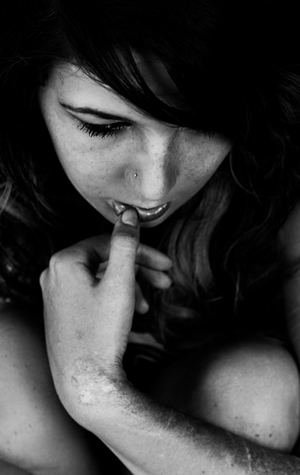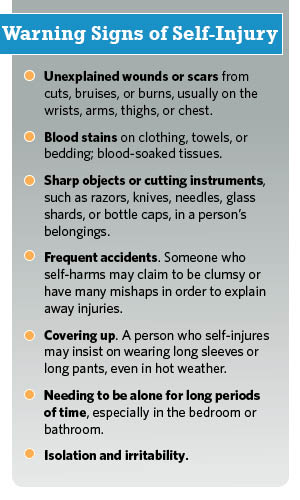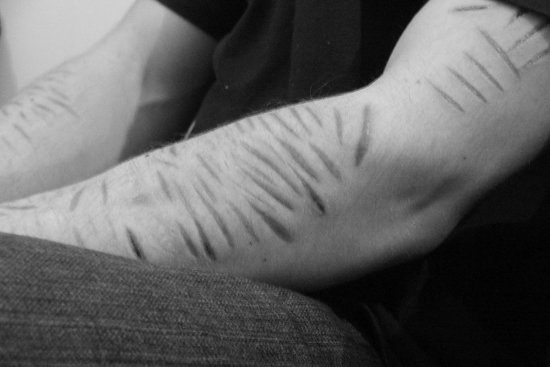Cutting: The Self-Injury Puzzle
For many, it feels good before it feels very, very bad

My head racing, can’t stop
My heart so broken and hurt
It stings, the first cut
It hurts so good.
I watch as the blade rips my pale skin.
—Entry from a self-injury blog
As a troubled BU sophomore, Sarah* hurt herself in order to feel better. She would occasionally resort to slicing her arms with razor blades, the escalation of a compulsion to self-injure that began in middle school, when she would furtively scratch herself with scissors. Alone in her dorm room, she’d experience a sense of release, of stress and pain lifting as she patted the pooling blood with gauze. But the effect was fleeting, and Sarah says any relief soon morphed into a deep sense of regret and shame over an act so private she kept it from even her closest friends.
As strange as the practice may seem to those who have never done it, cutting is fairly common, and Sarah, an articulate, high-achieving science major, is typical only in the sense that anyone can be a cutter. A groundbreaking 2006 study conducted by researchers at Princeton and Cornell found that 17 percent of college students self-injure—cut, carve, burn, or otherwise hurt themselves. More recent data indicate that 12 percent to 23 percent of adolescents have self-injured, and the behavior, which declines sharply with age, is more common among women—60 percent of those who self-injure are female. According to Mathilde Ross, a psychiatrist with Behavioral Medicine at BU Student Health Services, most cutters are not suicidal, and most outgrow the practice in their 20s.
Although self-injury has existed throughout history, the International Society for the Study of Self-Injury describes the practice specifically as the deliberate, self-inflicted destruction of body tissue without suicidal intent for purposes that aren’t widely socially acceptable or ornamental. Tattoos and piercings, no matter how extreme, don’t fall into the category of self-injury.
Why do young people cut themselves?
“It’s hard to feel anything when you’re depressed,” says Sarah, who habitually wore long sleeves to hide her scars. Cutting, she found, was “the only thing that would get an emotion.” At least before the shame and regret set in, self-injury helps people feel in control and makes them feel alive, or some alternative to feeling numb, Ross explains. It can release pain and tension and distract people from larger, overwhelming emotions. It’s a way of feeling something—anything, she says. Primarily, it appears to be a form of release.
The scars are “like proof of hurting,” says Sarah, who sought help for her cutting at Behavioral Medicine. “They’re are kind of like a personal tattoo you only want you to see.”

Numbers for how many people engage in cutting are hard to come by, but psychologists agree it is on the rise, and doctors like Ross admit to being somewhat at a loss when it comes to an apparent surge in self-injury among young people. She cites estimates by Barent Walsh, executive director of the Bridge of Central Massachusetts, a human service agency serving those with mental health, developmental, and family problems and acquired brain injury, that the incidence of self-injury climbed from 400 per 100,000 in the early 1980s to 1,000 per 100,000 in the late 1990s. One crisis hotline for young people reported a threefold increase in self-injury-related calls, from 696 in 2007 to 2,052 in 2011.
Another concern is that cutting has become, “for lack of a better word, a fad,” says Ross. Even before the internet, many young people discovered cutting after seeing evidence of it in their peers. But today the web is awash in pro-self-injury websites and social media glorifying the practice. One blog even has this disclaimer: “If you are quitting self-harm, then it isn’t really the place for you.” Several celebrities have spoken out about their struggles with self-injury, including singer-songwriter Fiona Apple, a rape victim who spoke frankly about her self-harm to Rolling Stone, and comedian and actor Russell Brand, who has written about making himself bleed. Alleged cutting also feeds the web gossip mill. After photos surfaced on the web supposedly showing singer Miley Cyrus with scarred wrists, a viral frenzy ensued and the 20-year-old became synonymous with cutting. (She denies it.)
The science of self-injury is young. “When I was in training there were people who believed cutting was suicidal behavior, “ says Ross, noting that an old clinical term for self-injury was “para-suicidal behavior.” But while some cutters may be deeply depressed and at higher risk of suicide, the practice itself—now referred to as NSSI (nonsuicidal self-injury)—is not intended to cause life-threatening harm, not viewed as a slippery slope to mortal injury, and often abates without any intervention.
Still, say mental health experts, cutting takes a concerning toll, not least because the shame associated with it can become so isolating. The urge to cut “would come on in a wave, usually at night,” says Sarah, who recalls feeling an overwhelming sense of loneliness.
Because the act is so private, each cutter develops and refines his or her own routine. “You’ll see sterilization with alcohol swabs, you’ll see razors, X-Acto knives, small kitchen knives, nail files, broken glass, an uncurled paper clip,” says Ross. “Some people have to make the cut bleed, others just need a physical sensation.”

One reason cutting causes less concern than other self-destructive behaviors, such as drug and alcohol use, is that it can be oddly effective. The response to cutting seems to be connected in some way to the body’s opioid system, the part of the nervous system that controls, pain, reward, and addiction, says Ross, noting that when it first caught the notice of clinicians in the 1980s the behavior was common among prison inmates and patients in psychiatric institutions. “In terms of the opiates, self-injury can be similar to a drug or cigarette habit,” she says. And like those addictions, it can be difficult to break. “What people who cut describe is that if they’re feeling anger or depression or emptiness, cutting will relieve it, but someone who has been cutting once a month could start cutting every day or multiple times a day.”
Although young people heal well, says Ross, “our main concerns about cutting are that it’s disfiguring—regular cutters develop scars—and cutters can have more serious incidents, if only by accident.” Cutting, she emphasizes, is never normal. “We’d like to see young people develop healthy ways to deal with stress. We think it’s important for all cutters to be evaluated.”
Ross urges students to tell someone. “To students who are self-injuring, I make the point that you’re not alone. That’s an important message,” she says, “because you’re dealing with emotional distress, and shame on top of that distress.”
Alicia* told someone. A gay BU freshman from a conservative family who refused to accept her sexual orientation, she began cutting as a high school freshman. “I would do it whenever I got upset or angry or suffering from stress about my sexuality,” says Alicia, who sought help at Behavioral Medicine at the insistence of her girlfriend and has been seeing a counselor there. “Self-harm was a way for me to forget about everything. I had no way to deal with emotional pain.” Like many self-injurers, Alicia learned about cutting through the media. “I’d watch TV shows and the characters would do self-harm, and I thought maybe somehow this would distract me,” she says. “At first I was very afraid. But as I got more used to the pain I started using different tools, sharper ones like X-Acto knives, that would cut deeper without any effort. I kept them in my drawer under stacks of paper.” Like Sarah, Alicia’s initial relief led to regret. “I hate feeling this crazy all the time,” says Alicia. “It’s a struggle.”
Ross says that some replacement behaviors have been found to be effective to stop cutting. “We’ll have someone wear a rubber band and snap it, and for some people that will help.” Others find that applying ice can substitute for the cutting sensation, and some people get relief by drawing a red line on their skin. These behaviors “can take the edge off,” she says.
After receiving counseling and being prescribed antidepressant medication, Sarah, now a junior, says she hasn’t cut in a year, but still struggles with the urge even as the scars on her arms fade. With the help of her therapist, she came up with a creative, poignant solution to stave off the urge to cut. Just before a much-anticipated tropical vacation with her family, Sarah says, her counselor urged her to horde the hotel’s complimentary body lotion and bring the vials home with her. “When I want to cut, I rub the lotion on my arms,” she says, “and the smell brings me back to that happy, safe place. I put it on all the time.” The impulse to cut still comes about once a month, but it’s fading with time. Sarah says she hopes she now has the tools “so I won’t hurt myself again.”
Those interested in seeking free, confidential mental health counseling can contact Student Health Services Behavioral Medicine at 617-353-3569.
*Names have been changed for this article.
Comments & Discussion
Boston University moderates comments to facilitate an informed, substantive, civil conversation. Abusive, profane, self-promotional, misleading, incoherent or off-topic comments will be rejected. Moderators are staffed during regular business hours (EST) and can only accept comments written in English. Statistics or facts must include a citation or a link to the citation.